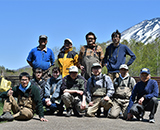
an endangered species of fish, in Shiribetsu
Award summary
Anglers rose up to protect Japanese huchen, which had lost their habitat due to environmental changes partially from river improvement work.
For more than 20 years, Obirame Restoration Group (president: Toshihiko Yoshioka), a volunteer group, has been engaged in activities for protecting Japanese huchen, which is an endangered salmonid species of freshwater, at the Shiribetsu River that flows in Kutchan, Abuta County, Hokkaido.
Japanese huchen in the Shiribetsu River have large bodies. Also known as obirame, which originates from Ainu, this species attracted a large number of anglers. However, the population declined sharply when they lost their habitat due to the environmental change, partly from improvement work for the Shiribetsu River carried out from 1980 to 1990.Anglers were the first to notice this abnormal change.In April 1996, the Obirame Restoration Group was established aiming to repopulate Japanese huchen in the Shiribetsu River. It was founded by a group of 10 anglers led by the late Seisaku Kusajima, who was known as a great master of fishing for Japanese huchen.
In cooperation with Hiroshi Kawamura, who was working for Hokkaido Prefectural Fish Hatchery (currently executive director of Obirame Restoration Group), members of the group searched in more than 50 locations to protect the habitats of Japanese huchen, only to find one Japanese huchen that was 10 centimeters in length. Although the group switched its policy to artificial hatch and release, it became necessary to formulate a long-term plan, because it takes nearly 10 years for Japanese huchen to mature. Therefore, in 2000, the group formulated the 30-Year Plan to Repopulate Obirame.
In May 2003, the group succeeded in artificial egg collection and insemination for the first time. From 2004 to 2018, they released approx. 7,800 artificially hatched juvenile Japanese huchen, marked by cut adipose fins. They were released into a tributary of the Shiribetsu River in nine installments. In 2012, it was confirmed that the juvenile fish had matured and reproduced naturally. In May 2019, the group confirmed that the descendants (second-generation) of the parent fish had propagated naturally. It was the first reintroduction, or natural reproduction without human aid, of Japanese huchen to be confirmed in Japan.
While this reintroduction experiment was in progress, a guard squad was established in 2011 to protect the naturally spawned eggs of Japanese huchen around the clock, which were discovered for the first time in nearly 20 years. Every year, for one month from mid-April, or the breeding season of Japanese huchen, members of the squad take turns watching the fish ascending upstream in the Shiribetsu River to protect them from anglers, 24 hours a day.
Currently, the Obirame Restoration Group has 80 members. Challenges include dissemination of the breeding activities, which they had carried out at a tributary of the Shiribetsu River, to other areas. They also include development of a legal environment for protecting Japanese huchen that have been released. The understanding of local residents is essential for advancing collaborations with the government for the creation of fishways, which help fish travel upstream in parts of the river with differences in height created for flood control, and in protecting the environment, including riparian forests that are good for the growth of juvenile fish. Accordingly, each May, the Obirame Restoration Group takes action for educating local residents about its activities, such as giving lectures at local elementary schools, taking students on field trips and holding explanatory meetings for local residents. Repopulating Japanese huchen in the Shiribetsu River is not the only goal of the Obirame Restoration Group. It also aims to have various species thrive in the river through its activities for protecting Japanese huchen.
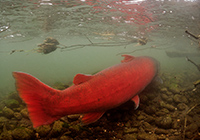 A male Japanese huchen with bright red nuptial coloration Estimated length: 1.2 meters (Photo: Satoshi Adachi)
A male Japanese huchen with bright red nuptial coloration Estimated length: 1.2 meters (Photo: Satoshi Adachi) 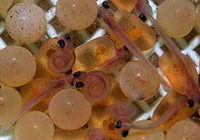 Among the eggs that are collected and inseminated artificially, the proportion of hatchlings is only 5%. They are nurtured carefully. (Photo: Yoshifusa Suzuki)
Among the eggs that are collected and inseminated artificially, the proportion of hatchlings is only 5%. They are nurtured carefully. (Photo: Yoshifusa Suzuki)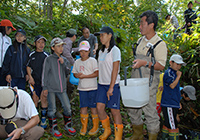 Since 2004, they have released approx. 7,800 juvenile fish into a tributary of the Shiribetsu River in nine installments. (Photo: Hideki Tamai)
Since 2004, they have released approx. 7,800 juvenile fish into a tributary of the Shiribetsu River in nine installments. (Photo: Hideki Tamai)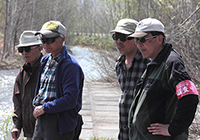 Every year, for about one month from mid-April, they take turns watching the river 24 hours a day to protect Japanese huchen ascending upstream in the Shiribetsu River from anglers.
Every year, for about one month from mid-April, they take turns watching the river 24 hours a day to protect Japanese huchen ascending upstream in the Shiribetsu River from anglers.Reasons for this award
The group focuses on the immediate environment and engages in patient activities driven by the members' pure desire for the repopulation of Japanese huchen.
We tip our hats to the efforts of people from the Obirame Restoration Group who have continued to engage patiently in time-consuming tasks, including egg collection, artificial insemination and the release of juvenile fish for more than 20 years. When addressing environmental issues, we tend to look at the global environment. We are glad that people look at their immediate surroundings and strive to protect the valuable species who live there. Their activities are supported by one thing-a simple, pure desire to increase the population of the beloved Japanese huchen. We are impressed with the strong will of the group's members.
Comments from the winner
Our group was formed with many anglers, researchers and other people based on the desire of one angler, who thought, "I want to increase the population of the huge Japanese huchen that have become things of the past." It has already been 20 years since we created the 30-Year Plan to Repopulate Obirame. We have succeeded in protecting the only tributary for natural spawning and creating a new tributary for natural reproduction by releasing juvenile fish. These achievements have increased our confidence to spread the activities to the overall Shiribetsu River. This honor that we received means that the protection of Japanese huchen as a local initiative was evaluated on the national level from the citizens' perspective. We are deeply grateful. At the same time, we would be happy if many people came to see the huge Japanese huchen in the Shiribetsu River, which have turned bright red, and be moved by the sight just like us. Thank you very much.






